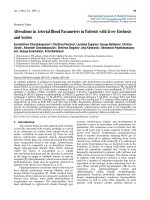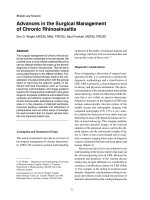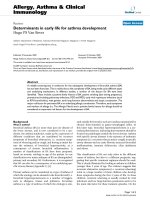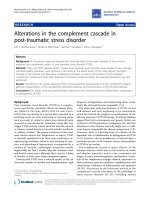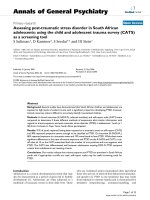Báo cáo y học: " Preferences in traumatic intracranial hemorrhage: bleeding vs. clotting" pot
Bạn đang xem bản rút gọn của tài liệu. Xem và tải ngay bản đầy đủ của tài liệu tại đây (120.38 KB, 2 trang )
Individuals who suff er traumatic intracranial hemor-
rhages (ICHs), the most common cause of morbidity and
mortality in adults younger than 40 years of age, not only
incur neurologic defi cits but also are at increased risk for
complications. warting such complications is para-
mount to preserving quality of life and improving the
likeli hood for survival. As such, preventing venous
thrombo embolism (VTE), the single most preventable
cause of morbidity and mortality in neurosurgical
patients, is of utmost priority. e decision to initiate
VTE prophylaxis in the setting of a traumatic ICH must
be carefully considered. Failure to use VTE prophylaxis
may result in serious or fatal pulmonary embolism (PE),
whereas the use of anticoagulants may potentiate further
intracranial bleeding, thereby worsening neurologic
function and possibly precipitating death. e paucity of
clinical trials addressing the safety and effi cacy of
chemical thromboprophylaxis in this patient population
leaves clinicians guessing in regard to the appropriate
dose, timing, and duration for thromboprophylaxis in the
presence of an ICH. us, it is left to the physician at the
bedside to weigh the risks versus benefi ts of anti-
coagulation in the face of the existing potential for a
serious PE or the progression of a head bleed. e pivotal
question is: how much preventive benefi t must be
provided in order to outweigh the potential bleeding risk?
In the previous issue of Critical Care, Scales and
colleagues [1] attempted to address this question and
illustrate the diffi culty of making this choice in traumatic
ICH patients, particularly within 24 hours of the injury.
In a decision analysis examining the risks of ICH progres-
sion versus the risks of VTE, the authors concluded that
there was no clear benefi t to providing (expected value =
0.89) or withholding (expected value = 0.90) thrombo-
prophy laxis with low-molecular-weight heparin (LMWH).
Although their results were incon clusive, they erred on
the side of caution and recom mended withholding
anticoagulant prophylaxis, particularly early after the
initial insult when bleeding progression is perceived to be
highest. Because the administration of blood thinners
could exacerbate bleeding in an enclosed space and result
in the worsening of already poor neurologic function,
these recommendations are reasonable.
On the other hand, the consequences of initiating VTE
prophylaxis in this population may not be as devastating
as one would think. In the general trauma population,
thromboprophylaxis is the standard of care because of
the astonishingly high incidence of deep venous throm-
bosis (DVT) development, which consistently exceeds
50% [2,3]. e ability of DVT prophylaxis to achieve a
substantial degree of risk reduction (approximately 50%),
coupled with an overall low major bleeding rate (less than
2%) [4], clearly demonstrates that the benefi ts of its use
outweigh the risks of bleeding. Except for the diff erence
in location of traumatic injury, those suff ering from
traumatic ICHs are no diff erent than the general trauma
population. To think that their risk of bleeding is
Abstract
Patients with traumatic brain injury and resultant
intracranial hemorrhage (ICH) are at high risk for
developing venous thromboembolism (VTE). The
use of thromboprophylaxis is e ective at decreasing
the rate of VTE, but at the potential expense of an
increased risk of ICH progression. Physicians must
carefully consider both the bene ts and risks of VTE
prophylaxis before prescribing chemical anticoagulants
to these patients. To help clarify this di cult choice,
Scales and colleagues performed a decision analysis to
determine whether the bene ts of thromboprophylaxis
outweigh the potential risk of worsening ICH. There
is increasing evidence that bleeding risks are not
as prominent as previously thought. Although the
results were largely inconclusive, the present study has
identi ed areas for future research.
© 2010 BioMed Central Ltd
Preferences in traumatic intracranial hemorrhage:
bleeding vs. clotting
Chee M Chan*
1
and Marya D Zilberberg
2,3
See related research by Scales et al., />COMMENTARY
*Correspondence:
1
Division of Pulmonary and Critical Care Medicine, Washington Hospital Center,
110 Irving Street NW #2B-39, Washington, DC 20010, USA
Full list of author information is available at the end of the article
Chan and Zilberberg Critical Care 2010, 14:153
/>© 2010 BioMed Central Ltd
increased simply because of the location of bleeding does
not seem biologically plausible. Additionally, prospective
observational evidence has shown that progression of
bleeding after traumatic head injuries is highest during
the fi rst 24-hour period, even in the absence of thrombo-
prophylaxis [5]. Despite initiation of DVT prophylaxis at
24 hours, the risk of bleeding does not signifi cantly
increase (4%) unless a surgical procedure is required.
us, in the appropriate patient suff ering from an ICH,
the advantages of thromboprophylaxis outweigh poten-
tial disadvantages.
In the same vein, emerging data suggest that pharma-
co logic prophylaxis with LMWH does not substantially
increase anti-Xa levels when used for DVT prophylaxis,
even for patients with severe renal impairment. e
DIRECT (Dalteparin’s Infl uence on the Renally Compro-
mised: Anti-Xa) study [6] demonstrated that in 99% of
patients with a creatinine clearance of less than 30 mL/
minute, trough anti-Xa levels were either undetectable
(less than 0.10 IU/mL) or minimal (0.10 to 0.20 IU/mL).
Additionally, no associa tion between major bleeding and
anti-Xa levels was found. erefore, if LMWH does not
accumulate even in the face of severe renal insuffi ciency,
the likelihood that it will accumulate and precipitate bleed-
ing seems low in a typical patient with traumatic ICH.
Growing evidence suggests that our current thrombo-
prophylaxis regimens are relatively safe and possibly even
suboptimal [7,8]. Taking the risk-benefi t equation one
step further, it is likely that the early administration of
DVT prophylaxis in this patient population may be less
hazardous than the alternative of full-dose anticoagu-
lation or an inferior vena cava (IVC) fi lter when VTE
actually develops. e potential long-term complications
associated with an IVC fi lter, namely IVC thrombosis,
migration of the fi lter [9], and increased risk for DVT
[10], must be contemplated before its placement. Despite
these considerations, the lack of concrete evidence from
a randomized controlled trial leaves physicians skeptical
about the safety of thromboprophylaxis in the setting of a
traumatic ICH. is uncertainty is mirrored in the
decision analysis by Scales and colleagues [1], in which
the estimated risk of ICH progression, even without
exposure to anticoagulants, ranged widely from 0.001 to
0.990. Hence, at the very least, the fi ndings of this study
illustrate that much research is still needed to clarify the
appropriate timing, dose, and patient characteristics to
safely administer VTE prophylaxis in this population.
Furthermore, this study has identifi ed the need for a risk
stratifi cation tool to select those patients who are at low
risk for ICH progression and would be ideal candidates
for DVT prophylaxis at 24 hours. In the meantime, while
we await more information, it seems that the decision to
administer thromboprophylaxis should be cautiously
considered on an individual basis.
Abbreviations
DVT, deep venous thrombosis; ICH, intracranial hemorrhage; IVC, inferior vena
cava; LMWH, low-molecular-weight heparin; PE, pulmonary embolism; VTE,
venous thromboembolism.
Competing interests
The authors declare that they have no competing interests.
Author details
1
Division of Pulmonary and Critical Care Medicine, Washington Hospital
Center, 110 Irving Street NW #2B-39, Washington, DC 20010, USA.
2
School of
Public Health and Health Sciences, University of Massachusetts, Arnold House,
715 North Pleasant Street, Amherst, MA 01003, USA.
3
EviMed Research Group,
LLC, Po Box 303, Goshen, MA 01032, USA.
Published: 14 May 2010
References
1. Scales D, Riva-Cambrin J, Wells D, Athaide V, Granton J, Detsky A: Prophylactic
anticoagulation to prevent venous thromboembolism in traumatic
intracranial hemorrhage: a decision analysis. Crit Care 2010 14:R72.
2. Geerts WH, Code KI, Jay RM, Chen E, Szalai JP: A prospective study of venous
thromboembolism after major trauma. N Engl J Med 1994, 331:1601-1606.
3. Kudsk KA, Fabian TC, Baum S, Gold RE, Mangiante E, Voeller G: Silent deep
vein thrombosis in immobilized multiple trauma patients. Am J Surg 1989,
158:515-519.
4. Geerts WH, Jay RM, Code KI, Chen E, Szalai JP, Saibil EA, Hamilton PA:
Acomparison of low-dose heparin with low-molecular-weight heparin as
prophylaxis against venous thromboembolism after major trauma. N Engl
J Med 1996, 335:701-707.
5. Norwood SH, McAuley CE, Berne JD, Vallina VL, Kerns DB, Grahm TW, Short K,
McLarty JW: Prospective evaluation of the safety of enoxaparin
prophylaxis for venous thromboembolism in patients with intracranial
hemorrhagic injuries. Arch Surg 2002, 137:696-701; discussion 701-692.
6. Douketis J, Cook D, Meade M, Guyatt G, Geerts W, Skrobik Y, Albert M,
Granton J, Hébert P, Pagliarello G, Marshall J, Fowler R, Freitag A, Rabbat C,
Anderson D, Zytaruk N, Heels-Ansdell D, Crowther M; Canadian Critical Care
Trials Group: Prophylaxis against deep vein thrombosis in critically ill
patients with severe renal insu ciency with the low-molecular-weight
heparin dalteparin: an assessment of safety and pharmacodynamics: the
DIRECT study. Arch Intern Med 2008, 168:1805-1812.
7. Geerts WH, Bergqvist D, Pineo GF, Heit JA, Samama CM, Lassen MR, Colwell
CW: Prevention of venous thromboembolism: American College of Chest
Physicians Evidence-Based Clinical Practice Guidelines (8th Edition). Chest
2008, 133 (6 Suppl):381S-453S.
8. Weitz JI, Hirsh J, Samama MM: New antithrombotic drugs: American
College of Chest Physicians Evidence-Based Clinical Practice Guidelines
(8th Edition). Chest 2008, 133 (6 Suppl):234S-256S.
9. Tardy B, Page Y, Zeni F, Lafond P, Decousus H, Bertrand JC: Acute thrombosis
of a vena cava lter with a clot above the lter. Successful treatment with
low-dose urokinase. Chest 1994, 106:1607-1609.
10. Decousus H, Leizorovicz A, Parent F, Page Y, Tardy B, Girard P, Laporte S, Faivre
R, Charbonnier B, Barral FG, Huet Y, Simonneau G: A clinical trial of vena
caval lters in the prevention of pulmonary embolism in patients with
proximal deep-vein thrombosis. Prevention du Risque d’Embolie
Pulmonaire par Interruption Cave Study Group. N Engl J Med 1998,
338:409-415.
doi:10.1186/cc8996
Cite this article as: Chan CM, Zilberberg MD: Preferences in traumatic
intracranial hemorrhage: bleeding vs. clotting. Critical Care 2010, 14:
153.
Chan and Zilberberg Critical Care 2010, 14:153
/>Page 2 of 2





